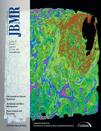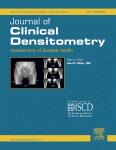Burrows, Melonie
Person Preferred Name
Melonie Burrows
Related Works
Content type
Digital Document
Abstract
Bone is a complex structure with many levels of organization. Advanced imaging tools such as high‐resolution (HR) peripheral quantitative computed tomography (pQCT) provide the opportunity to investigate how components of bone microstructure differ between the sexes and across developmental periods. The aim of this study was to quantify the age‐ and sex‐related differences in bone microstructure and bone strength in adolescent males and females. We used HR‐pQCT (XtremeCT, Scanco Medical, Geneva, Switzerland) to assess total bone area (ToA), total bone density (ToD), trabecular bone density (TrD), cortical bone density (CoD), cortical thickness (Cort.Th), trabecular bone volume (BV/TV), trabecular number (Tb.N), trabecular thickness (Tb.Th), trabecular separation (Tb.Sp), trabecular spacing standard deviation (Tb.Sp SD), and bone strength index (BSI, mg2/mm4) at the distal tibia in 133 females and 146 males (15 to 20 years of age). We used a general linear model to determine differences by age‐ and sex‐group and age × sex interactions (p < 0.05). Across age categories, ToD, CoD, Cort.Th, and BSI were significantly lower at 15 and 16 years compared with 17 to 18 and 19 to 20 years in males and females. There were no differences in ToA, TrD, and BV/TV across age for either sex. Between sexes, males had significantly greater ToA, TrD, Cort.Th, BV/TV, Tb.N, and BSI compared with females; CoD and Tb.Sp SD were significantly greater for females in every age category. Males' larger and denser bones confer a bone‐strength advantage from a young age compared with females. These structural differences could represent bones that are less able to withstand loads in compression in females.
Origin Information
Content type
Digital Document
Abstract
We examined the use of high-resolution peripheral quantitative computed tomography (HR-pQCT [XtremeCT; Scanco Medical, Switzerland]) to assess bone microstructure at the distal radius in growing children and adolescents. We examined forearm radiographs from 37 children (age 8–14 yr) to locate the position of the ulnar and radial growth plates. We used HR-pQCT to assess bone microstructure in a region of interest (ROI) at the distal radius that excluded the growth plate (as determined from the radiographs) in all children (n = 328; 9–21 yr old). From radiographs, we determined that a ROI in the distal radius at 7% of bone length excluded the radial growth plate in 100% of participants. We present bone microstructure data at the distal radius in children and adolescents. From the HR-pQCT scans, we observed active growth plates in 80 males (aged 9.5–20.7 yr) and 92 females (aged 9.5–20.2 yr). The ulnar plate was visible in 9 male and 17 female participants (aged 11.2 ± 1.9 yr). The HR-pQCT scan required 3 min with a relatively low radiation dose (<3 μSv). Images from the radial ROI were free of artifacts and outlined cortical and trabecular bone microstructure. There is currently no standard method for these measures; therefore, these findings provide insight for investigators using HR-pQCT for studies of growing children.
[ABSTRACT FROM AUTHOR]
Origin Information


